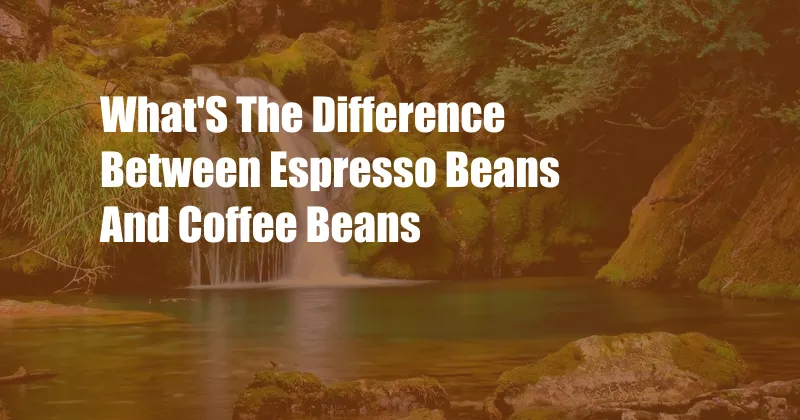
Espresso Beans vs. Coffee Beans: Unlocking the World of Exceptional Coffee
As a self-proclaimed java enthusiast, I’ve spent countless hours delving into the nuances of this aromatic beverage. One question that often sparks curiosity among coffee aficionados is the distinction between espresso beans and coffee beans. This dichotomy, born from different origins and unique characteristics, holds significance in the realm of coffee appreciation. Let’s embark on a journey to uncover the hidden differences, historical significance, and expert insights surrounding these two remarkable beans.
The Genesis of Coffee: A Tale of Two Origins
The origins of coffee beans and espresso beans are deeply intertwined yet distinct. Coffee beans, the foundation of all our beloved brews, trace their lineage back to the highlands of Ethiopia, where they were first cultivated over a thousand years ago. Espresso beans, on the other hand, emerged as a refinement much later, during the early 20th century in Italy, when coffee enthusiasts sought to create a more concentrated and intense brew.
Deciphering the Differences: A Symphony of Flavors and Techniques
While both espresso beans and coffee beans share the common denominator of coffee, their disparities lie in their distinct flavor profiles and brewing methods. Espresso beans, typically a blend of Arabica and Robusta varieties, undergo a more robust roasting process, giving them a darker hue and accentuated bitterness. Their dense texture and oily surface yield a concentrated, full-bodied flavor when extracted under high pressure.
In contrast, coffee beans encompass a broader spectrum of roasts and origins, catering to diverse taste preferences. From the mellow and nutty notes of light roasts to the smoky and intense profile of dark roasts, coffee beans offer a vast aromatic landscape. Their coarser grind and immersion in water during brewing result in a less concentrated but more nuanced flavor, highlighting the bean’s inherent characteristics.
Mastering the Art: Techniques for Optimal Flavor
Brewing espresso and coffee, while sharing similarities, demand distinct techniques to unlock their full potential. Espresso, the foundation of many beloved beverages like lattes and cappuccinos, requires finely ground beans and a specialized espresso machine capable of generating high pressure. The pressurized extraction process yields a rich, concentrated shot marked by a velvety crema.
Brewing coffee, on the other hand, encompasses a wider array of methods, each yielding unique flavor profiles. The classic drip method, utilizing a paper filter, offers a clean and balanced brew. French press immersion allows for a rich and full-bodied experience, showcasing the bean’s natural oils. Pour-over techniques, with their meticulous control over water temperature and flow rate, highlight the bean’s subtle nuances.
Expert Insights: Unveiling the Secrets of Exceptional Coffee
To delve deeper into the mastery of espresso and coffee, I sought the wisdom of renowned baristas and coffee experts. Their insights offer invaluable guidance for coffee enthusiasts seeking to elevate their brewing prowess.
- Grind Matters: The grind size plays a crucial role in extraction. Espresso beans require a fine grind, while coffee beans for drip or pour-over methods necessitate a coarser grind to prevent over-extraction.
- Water Temperature: Optimal water temperature varies depending on the brewing method. Espresso brewing demands water between 195-205°F (90-96°C), while drip coffee brewing typically favors temperatures around 195-205°F (90-96°C) for optimal flavor extraction.
- Extraction Time: Espresso extraction should occur within 25-30 seconds to achieve a balanced flavor. Coffee brewing times vary depending on the method, with drip coffee typically requiring longer steeping times (4-6 minutes) for optimal extraction.
A Compendium of Questions: Unraveling the Mysteries of Espresso and Coffee
To address the common queries surrounding espresso beans and coffee beans, I present a comprehensive FAQ section:
- Q: Can espresso beans be used for regular coffee brewing?
A: Yes, espresso beans can be used in regular coffee brewing methods, although their bolder flavor may not suit all palates. - Q: Is espresso stronger than regular coffee?
A: Espresso typically contains more caffeine per unit volume due to its finer grind and concentrated extraction, making it stronger than regular coffee. - Q: Can I grind espresso beans at home?
A: Yes, espresso beans can be ground at home using a burr grinder on the finest setting to achieve the desired fine grind.
Conclusion: A Journey of Discovery and Delight
The world of espresso beans and coffee beans is an ever-evolving realm of flavors, techniques, and expert insights. By understanding the nuances and distinctions between these two remarkable beans, we can elevate our coffee appreciation and embark on a journey of discovery that unveils the myriad wonders hidden within every cup.
So, dear reader, are you ready to embrace the enthralling world of espresso beans and coffee beans? Let us continue our exploration, unraveling the secrets of exceptional coffee together.